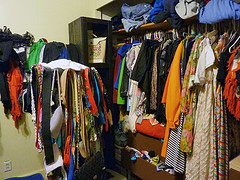 Some rights reserved by Lara604
Some rights reserved by Lara604
Glitzy, fun and ephemeral, nothing shrieks ‘disposable culture’ quite as much as the world of haute couture; its ‘here today, gone tomorrow’ mentality has pretty neatly stitched up the selling of clothes, from the catwalk, all the way down to the clothes store. But for most of us, packing into the malls for the latest seasonal bargains, fashion is fun and exciting, throwing a little sparkle into our lives.
In comparison, planet-saving can be seen to fall into the more dowdy of realms, for most – worthy, but, to be honest, just a little bit of a kill-joy. So anyone trying to match up these two different worlds, by dragging a green flourish into the wardrobe, would seem to have an uphill task.
However, this last decade has really seen a sea-change in approach in the world of fashion. There is a new generation of fashionista hotshots taking the helms, and they are looking at their craft through freshly acquired green-tinted spectacles. What they see isn’t pretty – from put-upon cotton farmers, to barely hidden sweatshops, to styles that are flung from shop-rail to dusty attic in the blink of an eye. The young guns see that it’s time to sweep their wardrobes clean, from top to bottom – and that this season’s sexy new color is green.
But, with real choice beginning to appear now, can you actually save the planet, just by choosing you clothes with a little more responsibility? The simple answer is a resounding yes – and it doesn’t have to involve holding back on style and panache.
The best place to start is with the fibers themselves; and here ethical clothing manufacturers and wearers can probably agree. Natural is best – with synthetic materials having a whole host of baddies stacked up against them. Most involve the use of known carcinogens in their processing, and they have little capacity to be recycled, or broken down naturally.
Nylon, in particular, has a high embodied energy content, meaning its manufacture involves excessive energy consumption. Worse, the production of this man-made fiber also releases quantities of the potent greenhouse gas, nitrous dioxide, which is 300 times more powerful a warming agent than carbon dioxide. Add to that the fact that all of these synthetic materials are derived from a non-renewable resource, petroleum, and you can see why these are very much fabrics of the old industrial world – and not a brave new eco-conscious one.
Next, when you are buying your natural fabric garments, checking out for the organic label is a must. Not only are organic cultivation methods kinder to the natural world, with pesticides and herbicides banished from the field – they help save the lives of farmers too. Hazardous farm chemicals are one of the main sources of ill-health and death in rural communities that produce clothing fibers – especially so for cotton.
Then there is the issue of saving the planet here and now – making it a better place for clothes-wearer, manufacturer and farmer, so that none exploits the other. This is where the principles of ethical working practices and fair trade step in. In order to guarantee the best prices for their produce, allowing scope for social investment, Fair Trade-certified fabrics pay a premium to developing world farmers. And in the factory and workplace, organizations such as the Fair Labor Association ensure that working conditions are the best, and wages decent.
Of course, these choices are not cost-free- you may pay more for your ethical clothes. But you should remember that you are taking on the costs that would otherwise be paid by others – exploited workers, impoverished farmers and a threatened future for the planet that would otherwise be gifted to your children and grand-children. And for those who have suffered from guilty pangs at the neatly folded (but barely-worn) clothes stacking up in their bedroom, the remedy is clear. Buy ethically and you will have fewer, but more fabulous clothes – of a quality that will continue to shine, along with all of our futures.
This article is a guest post from Adana, a stay at home mom with 3 cute kids (Jamie, Pablo, Guerrero) who writes on the topic of adjustable dumbbells
[…] Eco Child’s Play […]